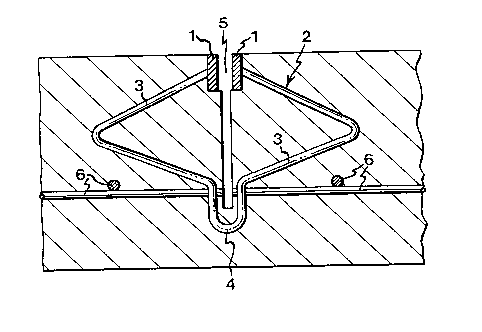Une partie des informations de ce site Web a été fournie par des sources externes. Le gouvernement du Canada n'assume aucune responsabilité concernant la précision, l'actualité ou la fiabilité des informations fournies par les sources externes. Les utilisateurs qui désirent employer cette information devraient consulter directement la source des informations. Le contenu fourni par les sources externes n'est pas assujetti aux exigences sur les langues officielles, la protection des renseignements personnels et l'accessibilité.
L'apparition de différences dans le texte et l'image des Revendications et de l'Abrégé dépend du moment auquel le document est publié. Les textes des Revendications et de l'Abrégé sont affichés :
| (12) Demande de brevet: | (11) CA 2151964 |
|---|---|
| (54) Titre français: | DISPOSITIF SERVANT POUR LES JOINTS DANS LES PLANCHERS DE BETON |
| (54) Titre anglais: | DEVICE FOR JOINTS IN CONCRETE FLOORS |
| Statut: | Réputée abandonnée et au-delà du délai pour le rétablissement - en attente de la réponse à l’avis de communication rejetée |
| (51) Classification internationale des brevets (CIB): |
|
|---|---|
| (72) Inventeurs : |
|
| (73) Titulaires : |
|
| (71) Demandeurs : | |
| (74) Agent: | SWABEY OGILVY RENAULT |
| (74) Co-agent: | |
| (45) Délivré: | |
| (86) Date de dépôt PCT: | 1993-11-29 |
| (87) Mise à la disponibilité du public: | 1994-06-23 |
| Licence disponible: | S.O. |
| Cédé au domaine public: | S.O. |
| (25) Langue des documents déposés: | Anglais |
| Traité de coopération en matière de brevets (PCT): | Oui |
|---|---|
| (86) Numéro de la demande PCT: | PCT/SE1993/001026 |
| (87) Numéro de publication internationale PCT: | SE1993001026 |
| (85) Entrée nationale: | 1995-06-15 |
| (30) Données de priorité de la demande: | ||||||
|---|---|---|---|---|---|---|
|
A device for joints in concrete floors is disclosed, comprising edge linings (1) and one or more clasps (2). The clasps (2) and the
edge linings (1) are interconnected in a fixed manner, and each clasp (2) is designed as two laterally projecting arches (3) which join in a
downwardly extending, arcuate projection (4). Moreover, a method for casting concrete floors is disclosed, comprising the steps of casting
the concrete floor on the base and steel trowelling of the concrete surface. The device is pressed down in the concrete before hardening
thereof, whereupon the edge linings (1) are adjusted in the steel trowelling of the concrete surface. The concrete floor is sawn between the
edge linings (1) to a depth which is smaller than the depth of the clasps (2), whereupon the now formed joints are filled with a semi-elastic
compound. Furthermore, means for pressing down or mounting of the device, and a casting method in which the device is mounted in situ
before casting are disclosed.
Note : Les revendications sont présentées dans la langue officielle dans laquelle elles ont été soumises.
Note : Les descriptions sont présentées dans la langue officielle dans laquelle elles ont été soumises.

2024-08-01 : Dans le cadre de la transition vers les Brevets de nouvelle génération (BNG), la base de données sur les brevets canadiens (BDBC) contient désormais un Historique d'événement plus détaillé, qui reproduit le Journal des événements de notre nouvelle solution interne.
Veuillez noter que les événements débutant par « Inactive : » se réfèrent à des événements qui ne sont plus utilisés dans notre nouvelle solution interne.
Pour une meilleure compréhension de l'état de la demande ou brevet qui figure sur cette page, la rubrique Mise en garde , et les descriptions de Brevet , Historique d'événement , Taxes périodiques et Historique des paiements devraient être consultées.
| Description | Date |
|---|---|
| Inactive : CIB de MCD | 2006-03-11 |
| Le délai pour l'annulation est expiré | 1997-12-01 |
| Demande non rétablie avant l'échéance | 1997-12-01 |
| Réputée abandonnée - omission de répondre à un avis sur les taxes pour le maintien en état | 1996-11-29 |
| Demande publiée (accessible au public) | 1994-06-23 |
| Date d'abandonnement | Raison | Date de rétablissement |
|---|---|---|
| 1996-11-29 |
Les titulaires actuels et antérieures au dossier sont affichés en ordre alphabétique.
| Titulaires actuels au dossier |
|---|
| SVEN-GUNNAR JONSSON |
| Titulaires antérieures au dossier |
|---|
| S.O. |